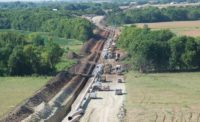Girling made the optimistic declaration just days after the U.S. State Dept. announced it would postpone a decision on the controversial 1,700-mile Canadian oil-sands pipeline until the first quarter of 2013.
After that announcement, Calgary, Alberta- based TransCanada said it would work with the state of Nebraska to develop a new route for the oil-sands pipeline that would avoid the environmentally sensitive Sand Hills region and the Ogallala aquifer.
Further, TransCanada is proposing to move ahead with the U.S.-only portion of the pipeline, from Cushing, Okla., to the Gulf Coast, while it awaits State Dept. approval for the cross-boarder section of the project.
But Wells Fargo analysts, in a note on Nov. 18, said it was unlikely that the company would be able to proceed on any portion of the line ahead of the government's schedule.
TransCanada spokesman Shawn Howard says TransCanada does not believe it needs a new environmental impact statement for the entire route, but simply a supplement to the EIS with details about the alternative route through Nebraska.
Houston-based Cardno Entrix, the third-party contractor hired by the State Dept. to assist in preparing the original EIS, has not been contacted to do any additional work, a Cardno Entrix spokesman said.
Girling told investors that TransCanada was in the process of signing a construction contract for the project when the State Dept. announced it would delay its decision.
The company has 90% of the rights-of-way secured and about 90% of the pipe and other equipment purchased and ready to move to a construction site.




